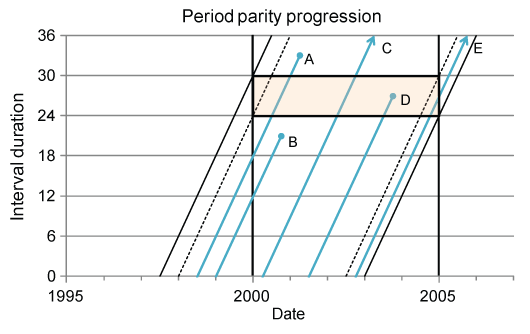Period parity progression ratios
Period parity progression ratios (PPRs) can be calculated for parity cohorts by taking all the births of a particular parity occurring in a specific year or other period of time as the numerator of the measure. For example, to calculate a'2 for Bangladesh in 2000–04 on a period basis, one would use information on the 3rd births occurring during that period, 2000–04.
Period PPRs describe parity progression in a synthetic parity cohort. The births all occur in the same period but a different parity cohort of women provides the information on fertility for each duration segment of the interval. Using this approach, one can calculate up-to-date PPRs for the period immediately before the data were collected.
Methods for calculating period PPRs were worked out in the 1980s by Ní Bhrolcháin (1987) and Feeney and Yu (1987). The births occurring in the period of interest are related to the number of women at risk of having these births. They are the women, for each duration segment of the birth interval, who had their previous birth sufficiently long ago to be exposed in the segment in question and did not give birth again before entering the segment.

The figure illustrates this. The women exposed at 24–29 months in 2000–04 are the women who gave birth to their 2nd child between the middle of 1997 and the end of 2002 and who did not have a third birth after an interval of less than 24 months or before the start of 2000. Thus they exclude Woman B in the figure although her 2nd birth occurred at a relevant date because she had her 3rd birth only 21 months after her 2nd one. Woman who had their 2nd birth between the end of 1997 and the middle of 2002 remain exposed to the risk of bearing a third child either to the end of the interval segment (Women A and Woman C) or until they give birth within it (Woman D). Thus, if they do not have their 3rd child in the segment, they are exposed for exactly 6 months. Women who had their 2nd child during last 6 months of 1997 or of 2002 contribute between 0 and 6 months exposure depending on the exact date at which they gave birth to their 2nd child and whether they have a 3rd child in the segment (Woman E).